JUNG SM1608 Bedienungsanleitung
JUNG
Nicht kategorisiert
SM1608
Lies die bedienungsanleitung für JUNG SM1608 (9 Seiten) kostenlos online; sie gehört zur Kategorie Nicht kategorisiert. Dieses Handbuch wurde von 3 Personen als hilfreich bewertet und erhielt im Schnitt 3.7 Sterne aus 2 Bewertungen. Hast du eine Frage zu JUNG SM1608 oder möchtest du andere Nutzer dieses Produkts befragen? Stelle eine Frage
Seite 1/9

Sensor module
Ref.No.: SM 1608
V03
Safety instructions
Caution! Electrical devices may only be installed and tted by electrically skilled persons.
Non-compliance with the installation information could cause damage to the device, re or other hazards.
Connect the module exclusively to the universal relay or dimming station (no mains potential!).
To fasten radio to the supporting ring, only use the enclosed plastic screws.
These instructions are a component part of the product and must remain with the end customer.
Function
Correct use
• Operation of consumers, e.g. light on/off, dimming, blinds/shutters up/down, calling up and saving light scenes etc.
• Connection to relay station or dimming station
• Installation in appliance box according to DIN 49073
Product characteristics
• Up to 16 load outputs of the relay or dimming station can be controlled.
• Switching, contact, dimming, blind/shutter
• Light scenes: up to 4 light scenes per control point can be freely congured.
• Central function: all assigned load outputs are switched on/off centrally.
• Free assignment of the sensor surfaces to the load outputs, central functions and light scenes
• Possible to change settings
• LED can be used as feedback and as orientation light
• Feedback of switching states on all connected sensor modules.
• LED brightness adjustable in 3 stages (100 %, 50 %, off).
• Up to 4 sensor modules can be connected to a single relay/dimming station, even with stations connected in paral-
lel.
• Cloning: transfer of a set assignment to another sensor module.
• If mains power fails, assignments are retained.
• Easy installation through 2-wire cable.
• Can be labelled using JUNG labelling tool.
Structure of the device
2 x (5)
2 x (2)
(1) (2) (3) (4) (5) (6) (7)
Fig.1.: Structure of the device
(1) Supporting ring
(2) Box screws
(3) Frame
(4) Sensor module
(5) Plastic screws
(6) Insert for labelling
(7) Cover
Operation
Operation is through touching the respective sensor surface (button).
Operating blind/shutter
• Move blind/shutter: press and hold button
• Stop or adjust blind/shutter: press button briey

Operating light (relay station)
Switching: press button briey (toggle mode)
Operating light (dimming station)
• Switching to switching-on brightness: press ON button briey
ⓘPressing and holding the OFF button switches to minimum brightness.
ⓘPressing and holding the ON button switches on and dims to maximum brightness.
Switching the light scene
• Press button briey
ⓘThe light scenes switch the outputs in sequence.
ⓘIn the light scenes, the dimming station switches to switching-on brightness only from the switched-off state.
Information for the electrically skilled person
Installation and electrical connection
DANGER!
Electric shock from touching live parts in the installation environment.
An electric shock can be fatal.
Before working on the device, disconnect the power and cover live parts in the area!
Supporting ring side for at design A
Supporting ring side for LS range.B
• Install supporting ring (1) in the right orientation on a ush-mount appliance box (designation „TOP“ = above;
„Type A“ or „Type B“ forwards)
Only use supplied box screws (2).
• Set frame (3) on the supporting ring.
• Connect sensor module (4) with the station and set onto the supporting ring. Connecting terminal downwards!
• Only fasten the sensor module to the supporting ring with the enclosed plastic screws (5). Only tighten the plastic
screws lightly (!).
• Snap the cover (7) with inserted inscription label or photo (6) onto the sensor module. Snap fastening on side of
cover.
DANGER!
When installing with 230 V devices under a common cover, e.g. socket outlets, there is a danger of elec-
tric shock in the event of an error!
An electric shock can be fatal.
Do not install any 230 V devices in combination with a push-button sensor expansion module under a
common cover!
- -+ +
A5
A6
A7
A8
A1
A2
A3
A4
MODE
OFF/o
ON/n
-
+
A1'
E1
A2'
E2
A3'
E3
A4'
E4
A5'
E5
A6'
E6
A7'
E7
A8'
E8
-
+
-
+
-
+
24 V SELV
24 V SELV
Fig.2.: Connection of max. 4 sensor modules to
the relay or dimming station.
ⓘPay attention to polarity
ⓘBefore setting parallel mode on the second station, the sensor module must be connected. Otherwise parallel
mode will not be recognised.
Start-up
In the state as delivered, the buttons (sensor elds) are allocated and the station outputs are assigned.

A1 A1 A2 A2
A3
A5 A5 A6 A6
A7 A7 A8 A8
A3 A4 A4
A1 A2 A3 A4
A5
A9 A10 A11 A12
A13 A14 A15 A16
A6 A7 A8
Fig.3.: Button assignment for connection to
one station A1 - 8 and to 2 stations
operated in parallel A1 - 16
ⓘThe operation mode of the load outputs must be selected on the relay station in correspondence to the requirement
(contact, switching, blind). The operation mode cannot be set on the sensor module.
Preliminary remark to programming
The program is called up by entering a 4-digit button combination twice. LEDs 1 - 6 light up.
Preliminary remark to grouping (button 1)
Assigning the relay or dimming station outputs to the buttons on the sensor module.
Up to 16 buttons can be assigned to a single output.
• Relay station: toggle mode. The output is switched on or off through the same button. In blind/shutter mode, one
channel for moving up and one channel for moving down are assigned.
• Dimming station: each load output is assigned 2 channels. Example: Load 1 switches on and dims brighter, channel
2 switches off and dims darker.
Preliminary remark to central function (button 2)
Central OFF and central ON can be assigned independently of each other.
Channels which should respond to the central function are set at the stations. In the state as delivered, all channels
respond to the central function.
Preliminary remark to light scene (button 3)
ⓘBefore setting the light scene, the station must be set through button 6.
Switching several outputs with one button.
Switching states are assigned to the outputs.
4 light scenes per control point are available.
Preliminary remark to LED brightness (button 4)
The LED brightness can be set for the switched-on and switched-off states.
Preliminary remark to tone (button 5)
Feedback tone when sensor module is actuated.
Preliminary remark to stations (button 6)
Indication of which stations, relay or dimming station, are connected.
Programming
Entering a 4-digit button combination brings you to the programming level.
The sensor module must be connected to the station.
In the following, „sensor surfaces“ are designated as „buttons“.
Programming mode from state as delivered or after reset
No change on the sensor module has taken place yet.
When grouping, central function or light scene are selected, all pre-set groupings are deleted. All surfaces can be
reassigned.
When LED brightness or tone is selected, the preset links are retained even when no changes have been made and
the area is left directly through button 16.
Changing the links
Settings that have been made can be changed in the respective area.
Programming level
Produktspezifikationen
| Marke: | JUNG |
| Kategorie: | Nicht kategorisiert |
| Modell: | SM1608 |
Brauchst du Hilfe?
Wenn Sie Hilfe mit JUNG SM1608 benötigen, stellen Sie unten eine Frage und andere Benutzer werden Ihnen antworten
Bedienungsanleitung Nicht kategorisiert JUNG
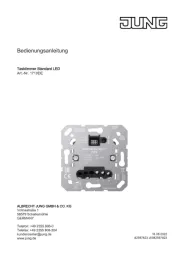
11 August 2025

10 August 2025
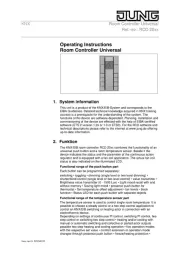
1 August 2025

1 August 2025
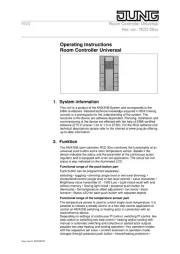
1 August 2025
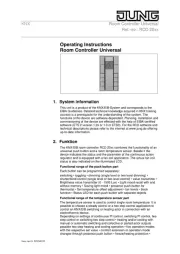
1 August 2025
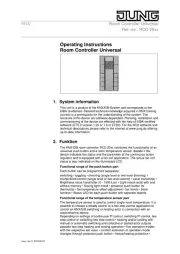
1 August 2025
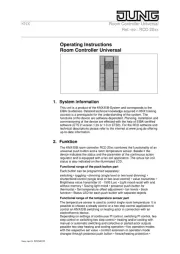
1 August 2025
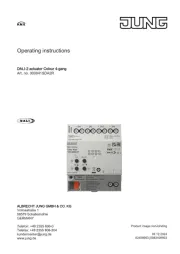
26 Juli 2025
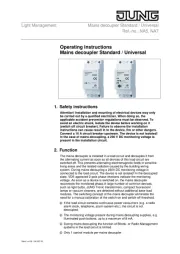
25 Juli 2025
Bedienungsanleitung Nicht kategorisiert
Neueste Bedienungsanleitung für -Kategorien-

15 August 2025

15 August 2025
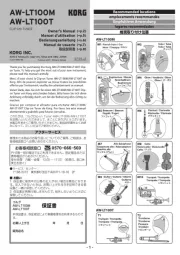
15 August 2025
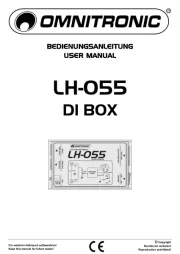
15 August 2025

15 August 2025
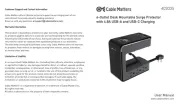
15 August 2025
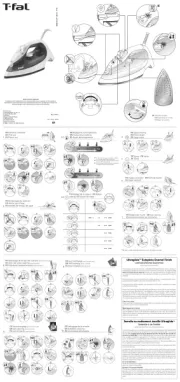
15 August 2025
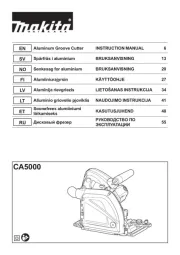
15 August 2025
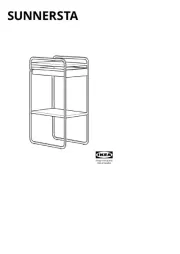
15 August 2025

15 August 2025